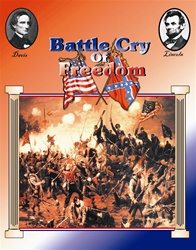

The song is still popular today and is heard on TV shows and movies about the war, at reenactment events, and at just about anything else having to do with the Civil War. Jefferson Davis felt forced to take up arms to.

We must settle this question now said Lincoln in 1861.
#Battle cry of freedom in lincoln free#
There was even a southern adaptation of the song, with changes in the lyrics, of course. Abraham Lincoln wondered whether in a free government the minority have the right to break up the government. Both sides of the American Civil war professed to be fighting for freedom. Printing presses could not keep up with the demand for the sheet music estimates of sales range from 500,000-750,000 copies over the course of the war. The song was an immediate hit with both the soldiers and the civilian population, and became an anthem for the Union cause on a par with The Battle Hymn of the Republic. Morale in the north was low following the Union Army’s defeat in the Peninsula Campaign. He received the Pulitzer Prize for his book Battle Cry of Freedom and Wikipedia states this was his most famous book. At that time, President Abraham Lincoln called for 300,000 more volunteers for the army and navy. He is considered to be an American Civil War historian and he is a professor at Princeton University. Root wrote The Battle Cry of Freedom in July of 1862. Both of those are sentimental pieces, but Root’s most famous contribution to Civil War music is a more rousing tune, The Battle Cry of Freedom. This authoritative volume makes sense of that vast and confusing „second American Revolution” we call the Civil War, a war that transformed a nation and expanded our heritage of liberty.Composer George Frederick Root wrote many popular Civil War songs, including The Vacant Chair and Just Before the Battle, Mother.

This „new birth of freedom,” as Lincoln called it, constitutes the proudest legacy of America's bloodiest conflict. Eventually, the North had to grapple with the underlying cause of the war-slavery-and adopt a policy of emancipation as a second war aim. The book's title refers to the sentiments that informed both the Northern and Southern views of the conflict: the South seceded in the name of that freedom of self-determination and self-government for which their fathers had fought in 1776, while the North stood fast in defense of the Union founded by those fathers as the bulwark of American liberty. Particularly notable are McPherson's new views on such matters as the slavery expansion issue in the 1850s, the origins of the Republican Party, the causes of secession, internal dissent and anti-war opposition in the North and the South, and the reasons for the Union's victory. Packed with drama and analytical insight, the book vividly recounts the momentous episodes that preceded the Civil War-the Dred Scott decision, the Lincoln-Douglas debates, John Brown's raid on Harper's Ferry-and then moves into a masterful chronicle of the war itself-the battles, the strategic maneuvering on both sides, the politics, and the personalities. James McPherson's fast-paced narrative fully integrates the political, social, and military events that crowded the two decades from the outbreak of one war in Mexico to the ending of another at Appomattox. Filled with fresh interpretations and information, puncturing old myths and challenging new ones, Battle Cry of Freedom will unquestionably become the standard one-volume history of the Civil War. But for much of the past half-century, freedom has largely been a Republican battle cry.


 0 kommentar(er)
0 kommentar(er)
